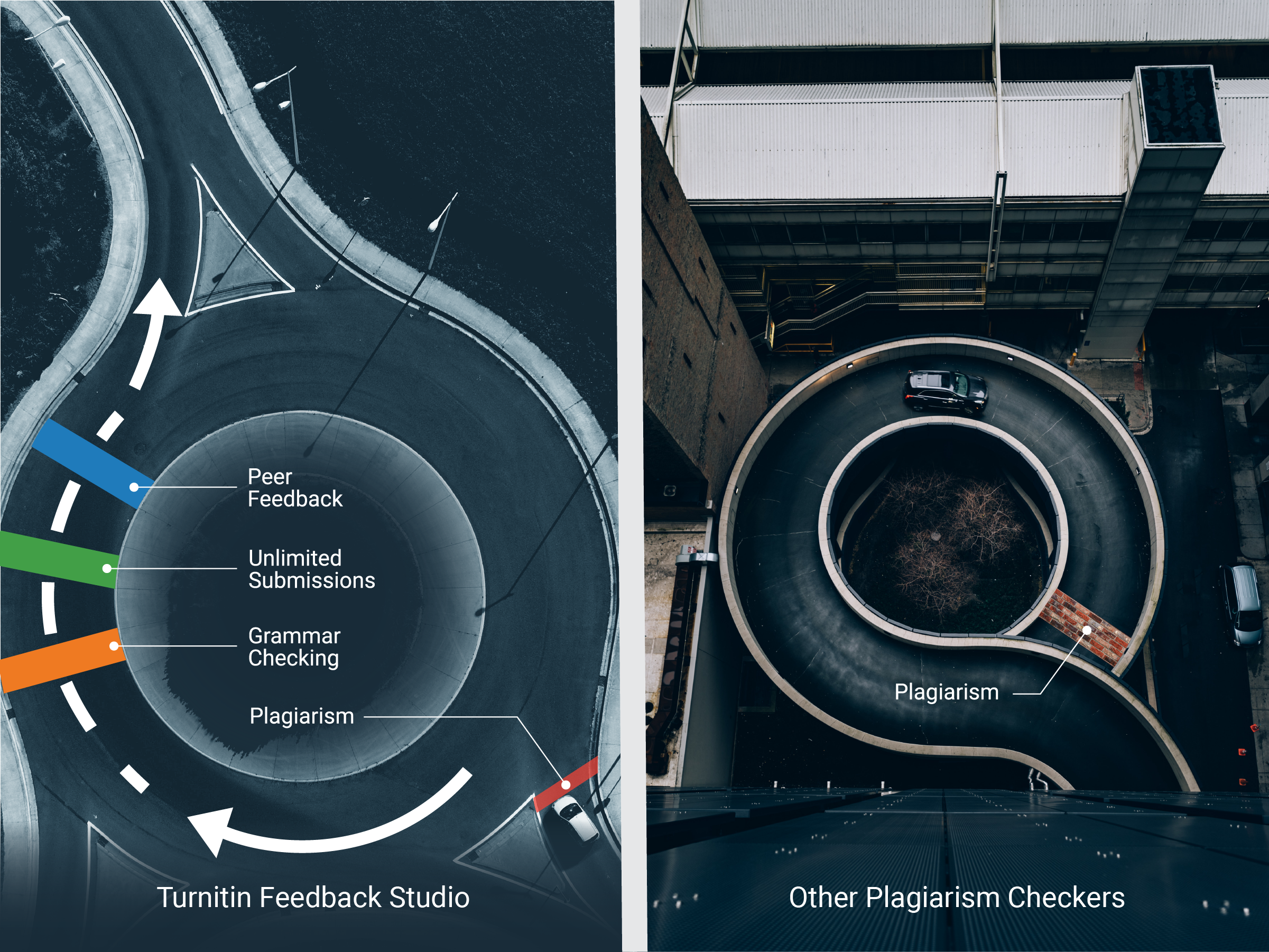With a wide variety of plagiarism checkers available on the market these days, it’s more important than ever to have a clear idea of your needs and pedagogical goals as you make your choice.
A note on the term “plagiarism checker”:
Because “plagiarism checker” is a term that is accusatory in tone and plagiarism detection is a judgment call that should be undertaken by humans, this isn’t a term Turnitin often uses. Turnitin doesn’t check for plagiarism in student work; we generate a report that provides text similarity and leave the academic judgment of whether work is plagiarized, to the instructor and academic leaders of an institution. That said, we acknowledge that “plagiarism checker” is an oft-used general term for tools that detect similarity.
We agree with researchers who state, “Plagiarism detection is an academic judgment, which is depending [sic] on plenty of factors, and only expert academicians can do this job” (Meo & Talha, 2019). Notable academic integrity researchers Foltynek, Guerrero-Dib, and Weber-Wulff state similarly, emphasizing, “Plagiarism and similarity are very different concepts. What these tools promise is to find overlapping texts in the document examined. Overlapping texts do not always indicate plagiarism, thus the decision about whether plagiarism is present or not should never be taken on the basis of a similarity percentage. The similarity reports of these tools must be inspected by an experienced human being, such as a teacher or an academic” (Foltýnek, et al., 2020).
We acknowledge that choosing a similarity checking tool can be a fraught process for academic leaders. So what are key criteria and questions to consider when finding the best solution for your students, faculty, staff, and overall institution? And how can a solution go beyond simply identifying similarity and potential plagiarism but also serve as a formative learning tool? How can a solution support the lofty goal of transforming plagiarism into a teachable moment?
What matters most in the evaluation of plagiarism checkers and similarity detection tools?
What pedagogical criteria should academic leaders consider in choosing a “plagiarism checker?”There are many factors to consider when choosing an edtech tool, and in turn, a plagiarism checker or similarity detection software. Pedagogical criteria are of utmost importance. An Edutopia article defines criteria in evaluating edtech tools as:
- Efficacy
- Student experience
- Intrinsic motivation
- Zone of proximal development
- And teacher experience (Miller, 2020)
How effective is the solution in upholding academic integrity and supporting student learning? While this factor is often muddied by marketing writing, it is a top question to ask when it comes to picking a similarity detection tool. The best option is to look at objective academic research and customer testimonials.
It is challenging to determine the efficacy of tools that haven’ t been around very long. Software that has been in existence for years or decades is subject to research and user stories that can provide transparency into how robust or helpful they are in upholding academic integrity. Multiple research projects over the years state that Turnitin Feedback Studio is effective in reducing plagiarism in student writing (Li, et al., 2021; Kostka & Maliborska, 2016; Batane, 2010; Baker, et. al., 2008).
Can the tool meet a variety of student needs? Is it accessible to all students regardless of disability or circumstance? How easy is it to use? The best similarity detection tools are ones that students are able to use and experience in positive ways so that they then use it consistently.
Research can also provide insights into student experience. According to Steppenbelt & Rowles, “Student perception of the usefulness and effectiveness of the use of the software was also very positive. Generally, due to the use of Turnitin and the accompanying focus this necessarily placed on the associated issues, students developed a sense that avoiding plagiarism is important. From this perspective, Turnitin appeared to be a successful learning tool in academic writing education” (Steppenbelt & Rowles, 2009).
Intrinsic motivationIs the similarity detection tool one that provides opportunities for learning? It is important to choose a tool where students set the goals, where they have access to feedback and information to guide them in the next steps of learning, and that these are primary features in the product.
A similarity detection tool—or “plagiarism checker”—should not discourage students or act as a policing device but rather provide them with a curiosity about learning and an appreciation of academic integrity.
Academic research found that “Turnitin can be used by learners in strategic ways that facilitated a deeper knowledge and capacity for academic writing practices. Students who demonstrated intentionality in their use of Turnitin engaged with the program in a nuanced way, which supported the self-identification of gaps in their academic literacy knowledge and skills. They then used an array of resources to develop their assignment and more broadly their own learning in this area” (Orlando, 2018).
Zone of Proximal DevelopmentVygotsky’s Zone of Proximal Development (ZPD) refers to an optimal learning space where the student is challenged with tasks that they cannot achieve alone but with guidance can proceed to next steps (Shabani, et. al., 2010). If the similarity detection tool can support students from unconscious incompetence to conscious competence in skill development, it effectively provides scaffolding for learning and supports the Zone of Proximal Development.
An excellent candidate for similarity detection will have ample opportunities for formative feedback so that plagiarism can be turned into teachable moments.
Research determined a decrease in similarity indices with continued student use of Turnitin. Steppenbelt & Rowles state, “Most students are genuinely interested in learning. The mechanistic application of citation and referencing rules, involving trial and error phases using the Turnitin software, may also be a necessary initial learning stage on the path to competent academic writing…Using the software, students received frequent feedback regarding the originality of their written work and whether sources had been properly acknowledged” (Steppenbelt & Rowles, 2009).
Teacher experienceFinally, a similarity detection tool needs to help faculty both in providing accurate and reliable information to determine a case of plagiarism or misconduct as well as opportunities to teach and guide students. Of course, too, it should be easy to use and optimally, free up time for teachers.
Ask other teachers for their experiences with similarity detection tools. Look to academic research and case studies for evidence on teacher experience. According to Lisa Simperingham, Academic Advisor of Digital Learning at Unitec, “At first, our teachers primarily used Turnitin Feedback Studio for similarity checking. However, as they got used to using the platform, more and more teachers started to use the different feedback functions, attaching rubrics and grading online…The feedback from teachers has been positive. They say that it makes grading faster and easier, and they like the flexibility of being able to do their marking from anywhere. Also, being online, it simplifies the process of returning graded assessments to students.”
Plagiarism detection shouldn’t be the main methodology in upholding academic integrity, but rather a backline defense. Similarity detection tools that guide students towards academic integrity are the most optimal solution. Additionally, effective assessment design and instruction, as well as honor codes are the foundation of preventing academic misconduct like plagiarism.
That said, according to notable academic integrity researchers, there are factors to consider when evaluating similarity detection tools.
At the 2021 International Center for Academic Integrity’s Conference, Dr. Debora Weber-Wulff presented her findings on various plagiarism detection tools. It was followed by a research article authored by various other notable scholars specializing in academic integrity.
In the article, researchers Tomáš Foltýnek, Dita Dlabolová, Alla Anohina-Naumeca, Salim Razı, Július Kravjar, Laima Kamzola, Jean Guerrero-Dib, Özgür Çelik, and Debora Weber-Wulff conducted an evaluation of the coverage and usability of most known similarity detection tools (Foltýnek, et. al., 2020).
Turnitin, Unicheck, Plagscan, and Urkund had the highest overall scores for coverage and usability as illustrated in their graph.
Author’s note: In 2020, Turnitin acquired Unicheck. In 2021, Turnitin acquired Ouriginal, composed of both Plagscan and Urkund.
For coverage evaluation, the research encompassed language coverage, types of plagiarism sources (e.g., open access journals, Wikipedia, and student papers), plagiarism types (e.g., copy and paste, synonym swapping, translation plagiarism), and single-source versus multiple-source documents.
For usability evaluation, the research reviewed workflow process, result presentation, and other usability issues (e.g., integration into an LMS, call support, and no external advertisements).
These criteria may be used to do your own evaluation and research of similarity detection tools, especially if you want to weigh one factor more than another.
Does your similarity detection tool support AI writing detection?AI writing tools like ChatGPT disrupted education in both positive and negative ways. While having essential conversations with students about proper AI writing tool use is the foundation to academic integrity, AI writing detection can also be a deterrent to AI writing tool misuse. While similarity detection tools focus on potential plagiarism, it is important to prepare for the future and ensure that your similarity detection tool is keeping pace with emerging trends in academic misconduct.
At Turnitin, we’ve developed solutions that both check for text similarity and deter plagiarism. It’s one thing to flag potential plagiarism, but the work of teaching students the value of original writing and proper citation isn’t done with that one step. Educators aren’t police—we are teachers—and our tools should fully support the entire writing process.
Here’s the ideal scenario: the best solution for combating plagiarism is deterrence and to turn instances of plagiarism into opportunities to facilitate original thinking.

It’s an ambitious goal—and we know that many of these “ivory tower” pedagogical notions are not realistic. But we’re trying to bridge that gap between ideals and reality. Yes, teachers want a way to check for plagiarism, full stop. But—what if—what if there was a tool that not only checked for plagiarism but could provide ongoing support to students and teachers to move towards original ideas and thinking?
Teachers are used to providing scaffolding to our students. But what if—what if—teachers had scaffolding in the form of software? What if there was software out there that checks for similarity, but also provides students with formative learning opportunities that lead to success in writing and beyond?
To put it simply, if you are looking for a plagiarism checker that upholds writing pedagogy, here are some questions you should ask yourself before choosing a solution for your institution:
- Does the service allow teachers to provide feedback on student work flagged as potential plagiarism?
- Does the service offer automated feedback to help students with revision? Plagiarism checking is important—but more important is to deter it by providing scaffolding and feedback throughout the writing process.
- Does the service only police or does it facilitate student growth? Can students use the service to improve their drafts and address citation or paraphrasing issues before submitting final work?
- Is the service grounded in best practices for teaching and learning? Does the service provide any classroom resources beyond the product itself? Does the service help teachers address skill gaps that can lead to plagiarism?
It’s time to find out.




